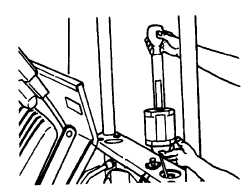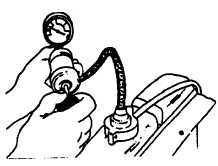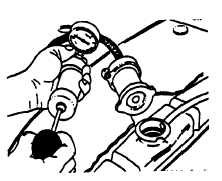| |
TM 10-3930-671-24
9.
Use a coolant tester to test the low temperature
protection ("freeze") level (proportion of ethylene
glycol to water) of the coolant solution. Add
coolant solution (antifreeze and/or water) to
provide maximum cooling system protection
(50/50 mixture).
Cooling System Pressure Tests
If the need is indicated for further maintenance and
testing of the cooling system, check for both external and
internal leaks in the cooling system with an accurate
pressure pump and gauge tester.
Cooling System Pressure (radiator cap): 14 psi (12-
16psi)
Refer to Section 2.1, Service Specifications, Cooling
System.
Radiator & Cooling System
1.
Pressure test the radiator cap to determine if it is
holding the correct pressure. Wash cap in clean
water to remove dirt or scale from sealing
surfaces. Wet rubber sealing surfaces and
install cap tightly on the tester. Pressurize tester
and radiator cap.
2.
The gauge pressure reading should be within the
specified limits of the cap relief pressure. If the
test relief pressure either exceeds or is below
the specified limits, replace cap.
Radiator Cap
1.
Pressure test the radiator and cooling system to
determine if it will hold the correct pressure
without leaks or failure. Wet the rubber sealing
surfaces and install the tester cap tightly on the
radiator filler neck. Apply pressure to the cooling
system equal to the radiator cap specified relief
pressure.
2.
Observe gauge reading for approximately 2
minutes. Pressure should not drop during this
time. If pressure drops, check for leaks in
radiator,
radiator
cap,
hoses,
connections,
engine components, etc.
Thermostat
1.
Remove and test the engine thermostat to
determine if it closes correctly and opens at the
specified temperature.
2.
Place thermostat fully immersed in a pan of
water. Heat the pan slowly while stirring water to
produce
an
even
temperature.
Use
a
thermometer to measure the temperature at
which the thermostat valve cracks (starts to
open) and, when it is fully open, measure the
valve lift distance of the fully opened valve. If
test results are not to specification, replace
thermostat.
3.
Replace the thermostat if even a slight opening
of the valve at normal temperature is found or if
its appearance shows any breakage. If the
sensing part is damaged, the thermostat valve
will remain closed.
F-96
|







